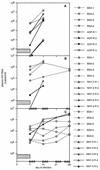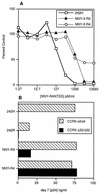Highly potent RANTES analogues either prevent CCR5-using human immunodeficiency virus type 1 infection in vivo or rapidly select for CXCR4-using variants - PubMed (original) (raw)
Highly potent RANTES analogues either prevent CCR5-using human immunodeficiency virus type 1 infection in vivo or rapidly select for CXCR4-using variants
D E Mosier et al. J Virol. 1999 May.
Abstract
The natural ligands for the CCR5 chemokine receptor, macrophage inflammatory protein 1alpha (MIP-1alpha), MIP-1beta, and RANTES (regulated on T-cell activation, normal T-cell expressed and secreted), are known to inhibit human immunodeficiency virus (HIV) entry, and N-terminally modified RANTES analogues are more potent than native RANTES in blocking infection. However, potent CCR5 blocking agents may select for HIV-1 variants that use alternative coreceptors at less than fully inhibitory concentrations. In this study, two N-terminal chemical modifications of RANTES produced by total synthesis, aminooxypentane (AOP)-RANTES[2-68] and N-nonanoyl (NNY)-RANTES[2-68], were tested for their ability to prevent HIV-1 infection and to select for coreceptor switch variants in the human peripheral blood lymphocyte-SCID mouse model. Mice were infected with a CCR5-using HIV-1 isolate that requires only one or two amino acid substitutions to use CXCR4 as a coreceptor. Even though it achieved lower circulating concentrations than AOP-RANTES (75 to 96 pM as opposed to 460 pM under our experimental conditions), NNY-RANTES was more effective in preventing HIV-1 infection. However, in a subset of treated mice, these levels of NNY-RANTES rapidly selected viruses with mutations in the V3 loop of envelope that altered coreceptor usage. These results reinforce the case for using agents that block all significant HIV-1 coreceptors for effective therapy.
Figures
FIG. 1
Inhibition of HIV-1 infection by AOP- and NNY-RANTES in cultured primary human PBMC. Virus replication was measured by p24 capsid antigen production after 5 to 7 days of infection. Infection was with two R5 variants of HIV-1 242: the original 242 isolate with an R at position 21 of V3 and a spontaneous mutant with H at position 21. These viruses are referred to as 242R and 242H, respectively.
FIG. 2
Inhibition in hu-PBL-SCID mice of HIV-1 infection by AOP- or NNY-RANTES. CCR5 antagonists were delivered by subcutaneously implanted osmotic pumps at the rate of 316 nM (2.5 μg)/h beginning 1 day before infection with the 242H isolate (see the text). A single dose of 126.6 μM (1 mg) of AOP-RANTES (A) or NNY-RANTES (B and C) was administered just prior to HIV-1 challenge. All animals thus received a bolus injection of compounds just prior to infection and continuous infusion of compounds from day −1 to at least day 7 after infection, as indicated by the horizontal bar in each panel. Data presented are plasma HIV RNA copies per milliliter at 1 to 4 weeks after infection, and each point represents the value for a single animal at each time point. Data collection was halted after 2 weeks in the first experiment (panel A), since all mice were positive. Two mice from each treatment group were sampled for human cell survival after 2 weeks of infection in the second experiment (panel B), so fewer values are recorded at later time points.
FIG. 3
(A) Inhibition of HIV-1 replication by NNY-RANTES in cultured PBMC. The HIV-1 isolates were the starting 242H virus and the HIV recovered from animals NNY-3 R4 and NNY-3 R5 from the experiment shown in Fig. 2C. These viruses were expanded in vitro for 7 days prior to the addition of NNY-RANTES. Envelope sequences were obtained from the virus at this time point and after 5 days of culture in the presence of 12.7 nM (100 mg/ml) NNY-RANTES. Sequences from the isolate NNY-3 R4 obtained after culture with NNY-RANTES matched the sequence shown in Table 2, part C, obtained directly from the infected hu-PBL-SCID mouse, but sequences obtained before the addition of NNY-RANTES showed several clones with a reversion to a 242 sequence. The NNY-RANTES inhibition data therefore reflect a population of virus sequences, with only a fractional representation of the NNY-RANTES resistant variants. (B) Replication of HIV-1 in cultured PBMC from a normal donor (CCR5 wt/wt) or a donor without CCR5 expression (CCR5 Δ32/Δ32). Both of the starting 242 virus isolates (H or R at position 21 of V3) were unable to replicate in the CCR5-negative cells, but the viruses recovered from mice NNY-3 R4 and NNY-3 R5 were able to replicate in these cells. As noted above, this experiment was done after 7 days of culture in normal PBMC, and there was no longer sequence homogeneity in the NNY-R4 and NNY-R5 isolates at this time.
FIG. 4
Coreceptor usage after NNY-RANTES treatment in vivo. The starting 242H isolate and the NNY-3 R4 isolate recovered from an NNY-RANTES treated mouse (Fig. 2C and Fig. 3) were tested for infection of GHOST cells transfected either with CXCR4 (A and C) or CCR5 (B and D). The 242H isolate could only infect GHOST cells expressing CCR5 (B), but the NNY-3 R4 isolate could infect both CXCR4 (C)- and CCR5 (D)-expressing cells.
Similar articles
- Variable sensitivity of CCR5-tropic human immunodeficiency virus type 1 isolates to inhibition by RANTES analogs.
Torre VS, Marozsan AJ, Albright JL, Collins KR, Hartley O, Offord RE, Quiñones-Mateu ME, Arts EJ. Torre VS, et al. J Virol. 2000 May;74(10):4868-76. doi: 10.1128/jvi.74.10.4868-4876.2000. J Virol. 2000. PMID: 10775626 Free PMC article. - PSC-RANTES blocks R5 human immunodeficiency virus infection of Langerhans cells isolated from individuals with a variety of CCR5 diplotypes.
Kawamura T, Bruse SE, Abraha A, Sugaya M, Hartley O, Offord RE, Arts EJ, Zimmerman PA, Blauvelt A. Kawamura T, et al. J Virol. 2004 Jul;78(14):7602-9. doi: 10.1128/JVI.78.14.7602-7609.2004. J Virol. 2004. PMID: 15220435 Free PMC article. - Aminooxypentane-RANTES induces CCR5 internalization but inhibits recycling: a novel inhibitory mechanism of HIV infectivity.
Mack M, Luckow B, Nelson PJ, Cihak J, Simmons G, Clapham PR, Signoret N, Marsh M, Stangassinger M, Borlat F, Wells TN, Schlöndorff D, Proudfoot AE. Mack M, et al. J Exp Med. 1998 Apr 20;187(8):1215-24. doi: 10.1084/jem.187.8.1215. J Exp Med. 1998. PMID: 9547333 Free PMC article. - HIV co-receptors as targets for antiviral therapy.
Schols D. Schols D. Curr Top Med Chem. 2004;4(9):883-93. doi: 10.2174/1568026043388501. Curr Top Med Chem. 2004. PMID: 15134547 Review. - Chemokines as natural HIV antagonists.
Verani A, Lusso P. Verani A, et al. Curr Mol Med. 2002 Dec;2(8):691-702. doi: 10.2174/1566524023361862. Curr Mol Med. 2002. PMID: 12462390 Review.
Cited by
- New antiretroviral inhibitors and HIV-1 drug resistance: more focus on 90% HIV-1 isolates?
Ndashimye E, Reyes PS, Arts EJ. Ndashimye E, et al. FEMS Microbiol Rev. 2023 Jan 16;47(1):fuac040. doi: 10.1093/femsre/fuac040. FEMS Microbiol Rev. 2023. PMID: 36130204 Free PMC article. Review. - Virus and target cell evolution in human immunodeficiency virus type 1 infection.
Mosier DE. Mosier DE. Immunol Res. 2000;21(2-3):253-8. doi: 10.1385/IR:21:2-3:253. Immunol Res. 2000. PMID: 10852125 Review. - Targeted delivery of PSC-RANTES for HIV-1 prevention using biodegradable nanoparticles.
Ham AS, Cost MR, Sassi AB, Dezzutti CS, Rohan LC. Ham AS, et al. Pharm Res. 2009 Mar;26(3):502-11. doi: 10.1007/s11095-008-9765-2. Epub 2008 Nov 11. Pharm Res. 2009. PMID: 19002569 Free PMC article. - Maraviroc.
Carter NJ, Keating GM. Carter NJ, et al. Drugs. 2007;67(15):2277-88; discussion 2289-90. doi: 10.2165/00003495-200767150-00010. Drugs. 2007. PMID: 17927288 Review. - Donor- and ligand-dependent differences in C-C chemokine receptor 5 reexpression.
Sabbe R, Picchio GR, Pastore C, Chaloin O, Hartley O, Offord R, Mosier DE. Sabbe R, et al. J Virol. 2001 Jan;75(2):661-71. doi: 10.1128/JVI.75.2.661-671.2001. J Virol. 2001. PMID: 11134280 Free PMC article.
References
- Alkhatib G, Liao F, Berger E A, Farber J M, Peden K W. A new SIV co-receptor, STRL33. Nature. 1997;388:238. . (Letter.) - PubMed
- Arenzana-Seisdedos F, Virelizier J L, Rousset D, Clark-Lewis I, Loetscher P, Moser B, Baggiolini M. HIV blocked by chemokine antagonist. Nature. 1996;383:400. . (Letter.) - PubMed
- Berger E A. HIV entry and tropism: the chemokine receptor connection. AIDS. 1997;11:3–16. - PubMed
- Berger E A, Doms R W, Fenyo E M, Korber B T, Littman D R, Moore J P, Sattentau Q J, Schuitemaker H, Sodroski J, Weiss R A. A new classification for HIV-1. Nature. 1998;391:240. . (Letter.) - PubMed
Publication types
MeSH terms
Substances
LinkOut - more resources
Full Text Sources
Other Literature Sources
Medical



